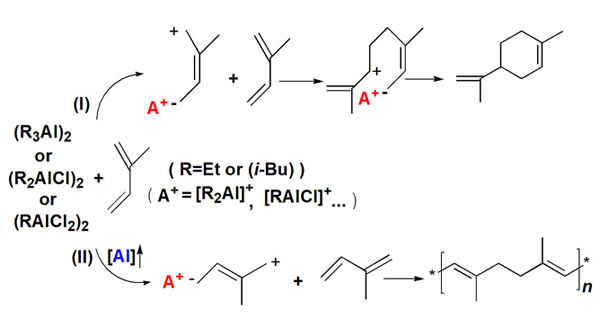[1] Mori, H.; Hasebe, K.; Terano, M. Polymer 1999, 40, 1389.
[2] Yang, H. R.; Zhang, L. T.; Zang, D. D.; Fu, Z. S.; Fan, Z. Q. Catal. Commun. 2015, 62, 104.
[3] Bahri-Laleh, N.; Correa, A.; Mehdipour-Ataei, S.; Arabi, H.; Haghighi, M. N.; Zohuri, G.; Cavallo, L. Macromolecules 2011, 44, 778.
[4] Liu, B. P.; Nitta, T.; Nakatani, H.; Terano, M. Macromol. Chem. Phys. 2002, 203, 2412.
[5] Liu, B. P.; Nitta, T.; Nakatani, H.; Terano, M. Macromol. Chem. Phys. 2003, 204, 395.
[6] Liu, B. P.; Nitta, T.; Nakatani, H.; Terano, M. Macromol. Symp. 2004, 213, 7.
[7] Potapov, A. G.; Terskikh, V. V.; Zakharov, V. A.; Bukatov, G. D. J. Mol. Catal. A:Chem. 1999, 145, 147.
[8] Potapov, A. G.; Terskikh, V. V.; Bukatov, G. D.; Zakharov, V. A. J. Mol. Catal. A:Chem. 2000, 158, 457.
[9] Hu, J.; Han, B.; Shen, X. R.; Fu, Z. S.; Fan, Z. Q. Chin. J. Polym. Sci. 2013, 31, 583.
[10] Franceschini, F. C.; Tavares, T. T. D. R.; Greco, P. P.; Galland, G. B.; dos Santos, J. H.; Soares, J. B. J. Appl. Polym. Sci. 2005, 95, 1050.
[11] Rocha, T. C. J.; Coutinho, F. M. B.; Soares, B. G. Polym. Bull. 2009, 62, 1.
[12] Gao, H.; Liu, X.; Tang, Y.; Pan, J.; Wu, Q. Polym. Chem. 2011, 2, 1398.
[13] Huang, W. Q.; Yang, L.; Zhao, X.; Man, Y.; Li, B. Y.; Zhang, Y.; Yang, W. T. Chem. Ind. & Eng. Pro. 2011, 30, 1231(in Chinese). (黄文氢, 杨岭, 赵曦, 满毅, 李秉毅, 张颖, 杨万泰, 化工进展, 2011, 30, 1231.)
[14] Blaakmeer, E. S. M.; van Eck, E. R. H.; Kentgens, A. P. M. Phys. Chem. Chem. Phys. 2018, 20, 7974.
[15] Niu, Q. T.; Zhang, J. Y.; Peng, W.; Fan, Z. Q.; He, A. H. Mol. Catal. 2019, 471, 1.
[16] Richardson, W. S. J. Polym. Sci. 1954, 13, 325.
[17] Ferington, T. E.; Tobolsky, A. V. J. Polym. Sci. 1958, 31, 25.
[18] Dolgoplosk, B.; Belonovskaia, G. P.; Boldyreva, I. I.; Nelson, K. V.; Kropacheva, E. N.; Rosinoer, J. M.; Chernova, J. D. J. Polym. Sci. 1961, 53, 209.
[19] Kennedy, J. P.; Squires, R. G. Polymer 1965, 6, 579.
[20] Binder, J. L. J. Polym. Sci. Part A:Gen. Pap. 1963, 1, 37.
[21] Kössler, I.; Vodehnal, J.; Štolka, M. J. Polym. Sci. Part A:Gen. Pap. 1965, 3, 2081.
[22] Pétiaud, R.; Taärit, Y. B. J. Chem. Soc. 1980, 10, 1385.
[23] Peng, Y. X.; Deng, Y. G.; Liu, J. L.; Dai, H. S.; Cun, L. F. Polym. Mater. Sci. Eng. 1997, 13, 95(in Chinese). (彭宇行, 邓勇刚, 刘佳林, 戴汉松, 寸琳峰, 高分子材料科学与工程, 1997, 13, 95.)
[24] Gaylord, N. G.; Matyska, B.; Mach, K.; Vodehnal, J. J. Polym. Sci. Pol. Chem. 1966, 4, 2493.
[25] Gaylord, N. G.; Kössler, I.; Matyska, B.; Mach, K. J. Polym. Sci. Pol. Chem. 1968, 6, 125.
[26] Matyska, B.; Doležal, I.; Kössler, I. Collect. Czech. Chem. C 1971, 36, 2924.
[27] Uchida, Y.; Furuhata, K. I.; Ishiwata, H. Bull. Chem. Soc. Jpn. 1971, 44, 1118.
[28] Akutagawa, S.; Taketomi, T.; Otsuka, S. Chem. Lett. 1976, 5, 485.
[29] Shen, G. L. Journal of Liaoyang Petrochemical College 1996, 12, 1(in Chinese). (沈国良, 辽阳石油化专学报, 1996, 12, 1.)
[30] Yu, S. J. Speciality Petrochemicals 2000, (2), 20(in Chinese). (于士君, 精细石油化工, 2000, (2), 20.)
[31] Shen, G. L.; Tang, L. H. Speciality Petrochemicals 2004, (1), 17(in Chinese). (沈国良, 唐丽华, 精细石油化工, 2004, (1), 17.)
[32] Xia, S. W.; Xia, S. W.; Ma, S. X. Acta Polym. Sinica 1998, (3), 262(in Chinese). (夏树伟, 夏少武, 马世学, 高分子学报, 1998, (3), 262.)



